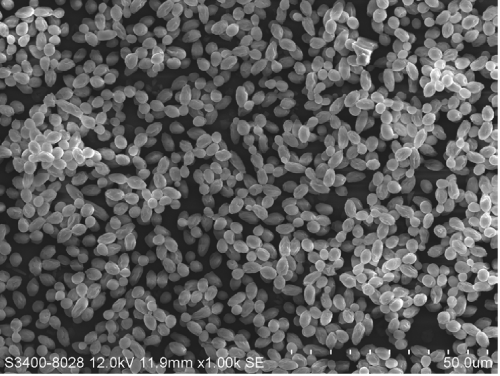
Clinical Image
Austin J Clin Case Rep. 2014;1(3): 1011.
SEM Image of Candida Albicans Biofilms on Plastic Coupons
Tsang PWK1 and Lam OLT2*
1Department of Oral Biosciences, University of Hong Kong, Hong Kong
2Department of Oral Rehabilitation, University of Hong Kong, Hong Kong
*Corresponding author: Lam OLT, Department of Oral Rehabilitation, The University of Hong Kong, 4A22 Pokfulam Road, Hong Kong
Received: May 30, 2014; Accepted: June 12, 2014; Published: June 14, 2014
Clinical Image
Candida is a genus of human fungal opportunistic pathogens implicated in localized infections of the oral mucosa, and oral colonization has been associated with pneumonia [1] and sepsis [2]. Candida is the fourth leading cause of nosocomial bloodstream infections in hospitalized patients [3]. Approximately 80% of infections are associated with biofilm formation, and Candida in biofilms demonstrate increased resistance to antifungal therapies [4,5].
Fungal biofilms were prepared on custom-made, pre-sterilized coupons. An inoculum of Candida albicans was transferred onto the coupons and incubated for 1.5 h at 37oC with agitation. After the adhesion phase, the coupons were washed twice, fresh YNB medium added, and further incubated for 24 h at 37oC. Thereafter, the coupons were washed twice and placed in 1% osmium tetroxide for 1 h. Samples were subsequently washed with distilled water, dehydrated in a series of ethanol solutions (70% for 10 min, 95% for 10 min and 100% for 20 min), and air-dried overnight in a desiccator prior to sputter coating with gold (JFC1 100; JEOL). The surface topographies of the C. albicans biofilms were viewed with a scanning electron microscope (Philip XL30CP).
Figure 1 :
References
- Barkauskas CE, Perfect JR. "Candida pneumonia: What we know and what we don’t." Current Fungal Infection Reports. 2009; 3: 21-31.
- Dongari-Bagtzoglou A. "Pathogenesis of mucosal biofilm infections: challenges and progress." Expert Rev Anti Infect Ther. 2008; 6: 201-208.
- Gautam H, Kaur R. "Oral thrush to candidemia: a morbid outcome." J Int Assoc Physicians AIDS Care (Chic). 2010; 9: 325-327.
- Lewis RE. "Overview of the changing epidemiology of candidemia." Curr Med Res Opin. 2009; 25: 1732-1740.
- Tsang PW, Bandara HM. "Purpurin suppresses Candida albicans biofilm formation and hyphal development." PLoS One. 2012; 7: 50866.
